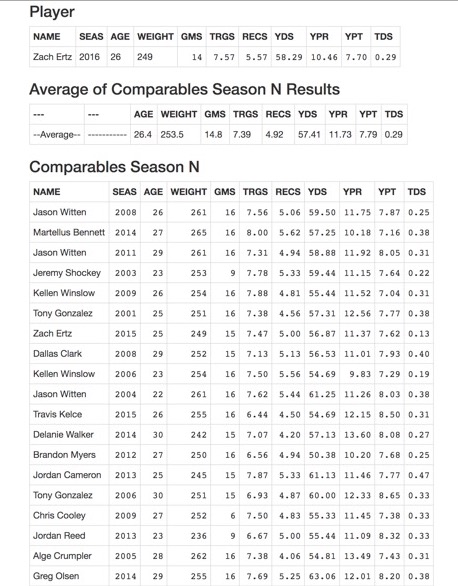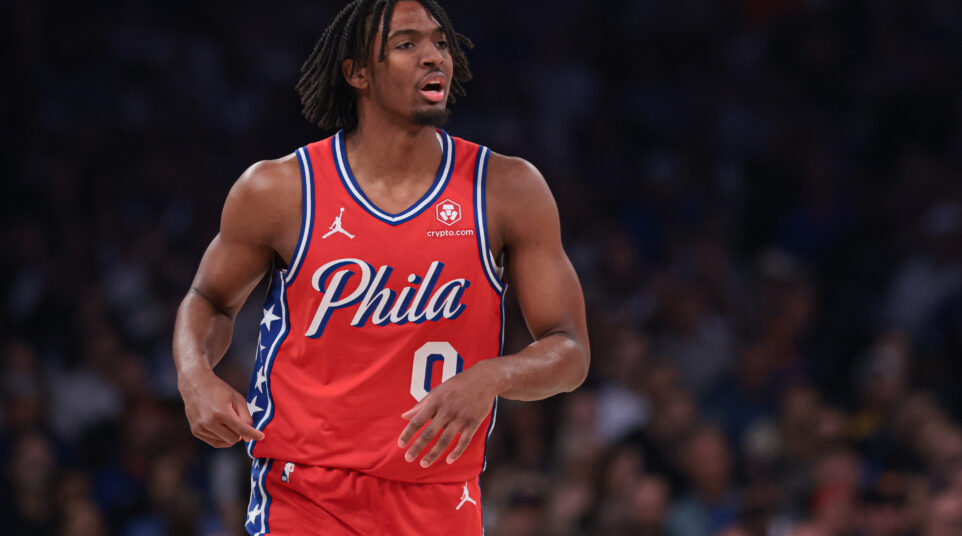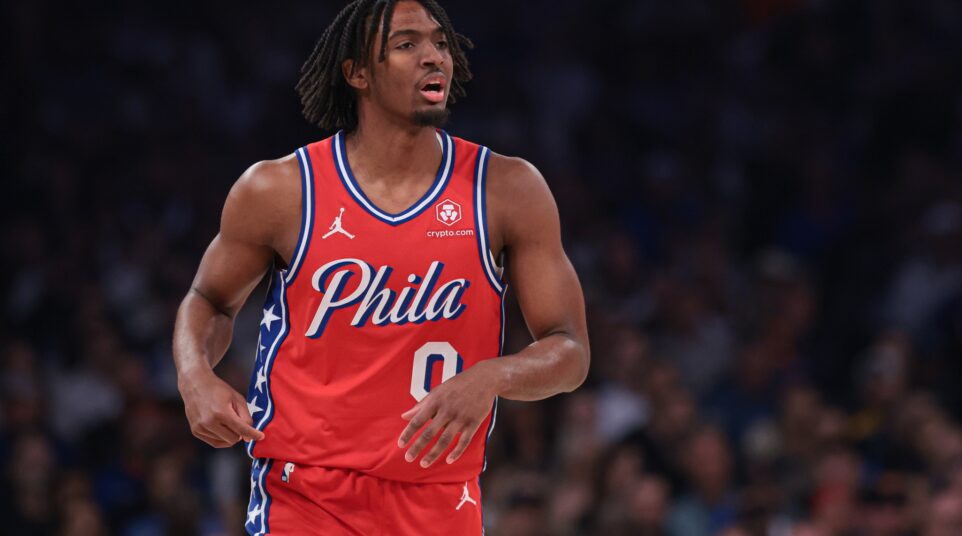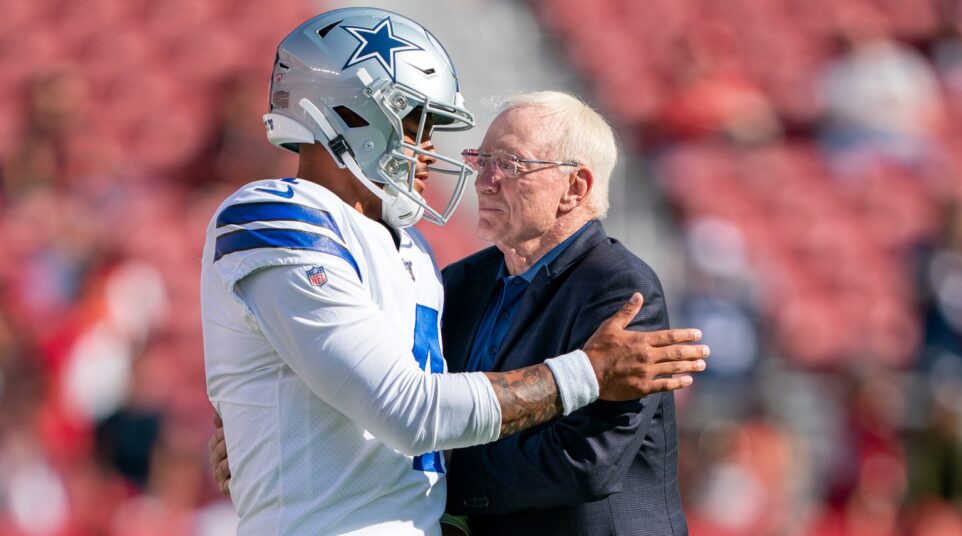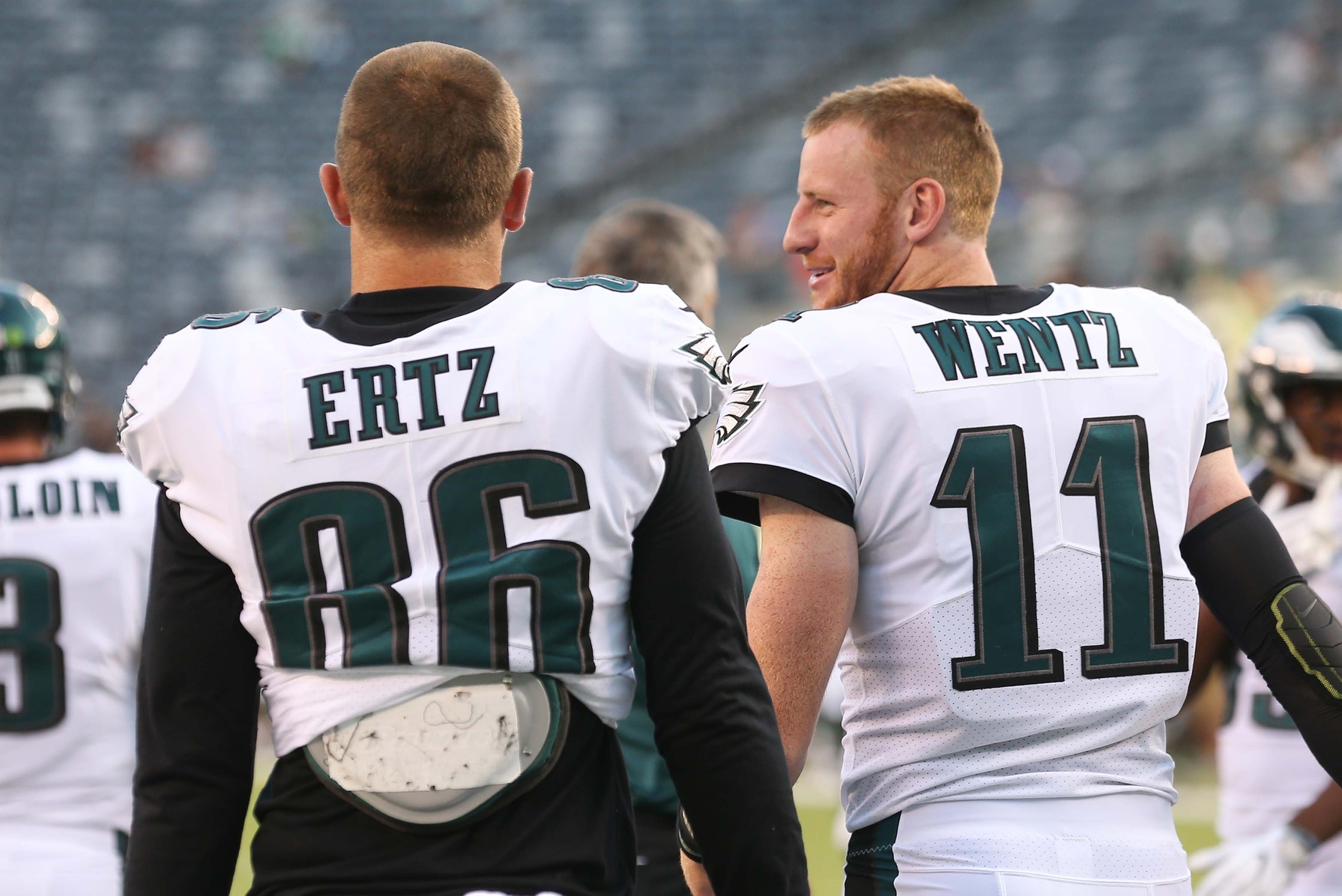
This Is The Year Zach Ertz Actually Breaks Out, and Other Fantasy Values for Week 1
Jim McCormick has covered fantasy football for ESPN for over 10 years. Each week, he’ll go over the best daily fantasy values and waiver wire pickups. This week, he focuses on Zach Ertz, who is poised for a breakout season in both fantasy and real-life. The numbers say so.
Baseball front offices got infinitely sharper when it became clear amid the Moneyball era that a range of outcomes for each player could be compared against the huge database of previous performance.
For instance, it wouldn’t take a very sophisticated statistical model to map out the very likely demise of aging power hitters. If age, injury history, and diversity of skills—such as defense and plate discipline—were factored in, you’d assume no competent general manager would have allocated Ryan Howard the money and years Ruben Amaro Jr. did in April of 2010.
It’s not that it was impossible for Howard to live up to the massive pact, it’s that doing so would have required bucking a massive sample size of Cecil Fielders before him. Amaro was betting a 34-year-old Howard would still be mashing instead of just cashing. There is an alternative outcome, likely one that would only occur with a probability of five or six percent, where Howard carried the Phillies’ power production into his mid-30s. In the end, the most likely outcome unfolded.
Banking on outliers isn’t always an awful practice, as there are undoubtedly human elements to a player and/or team that no spreadsheet can consider. Data shouldn’t define the decision process, but it should be part of it. Systemic dismissal of clear trends is often managerial malpractice in professional sports.
To pivot to fantasy football, Amaro definitely drafted Adrian Peterson and Frank Gore on all of his teams this season.
We’ll allow that incredibly overwritten intro to segue into a discussion of the upcoming NFL season through the lens of fantasy football and nerdy numbers. Football doesn’t translate nearly as well to predictive analytics as baseball, the ultimate Excel sport, but we do have an increasingly rich base of data to consider.
The Amaro example serves as precedent to consider how established trends should earn our attention when analyzing sports, particularly at the fantasy level. (I also used to cover the Phillies, and Amaro would have a separate presser at 3 PM most days, like 90 minutes before Charlie and the players were available for BP. All so he could tell the 11 disheveled reporters Utley’s knee was doing better. Thus, I’ll take shots when I can.)
Viewing the Eagles as a fantasy portfolio, I’m finally buying Zach Ertz as a breakout fantasy commodity after years of fading him. Rotoviz posts similarity comps for each skill position to help us get an idea of which previous seasons are viable future outcomes for a given player. We find Ertz in some strong company in regards to his career arc.
What have tight ends with similar age, experience, physical measurables and production to Ertz accomplished in past seasons?
Jason Witten finished second to Tony Gonzalez at the position in PPR (point-per reception) formats in 2008. Martellus Bennett was fourth behind only historic touchdown producers Rob Gronkowski, Jimmy Graham and Antonio Gates in 2014. Witten was fifth at the position in fantasy production in 2011. The top career comparables for Ertz suggest he’s wading in the top-five territory among tight ends for 2017. Sure, Ertz could be a low-end outlier of this collective, but I’m willing to bet he’s closer the median performance. I find the results of this comparative tool intriguing beyond fantasy football, as this is an Eagles team that really doesn’t have any impressive youth at the skill positions, thus it could prove pivotal to have a mid-20s player like Ertz take his game to another level.
A lack of touchdowns on Ertz’s resume has in part kept him from consideration for the top-tier at the position in both real and fantasy regards, but opportunity rates suggest positive regression should be on the way. The larger set of numbers suggest a correction is coming.
Ertz fielded 16 targets in the end zone over the past two seasons, tied with Gronkowski (who played six fewer games over this sample) for eighth at the position. Ertz caught four of these valuable looks for touchdowns– 25%. The conversion rate for NFL tight ends since 2015 is 43%. Cincinnati’s Tyler Eifert sports a ridiculous 79% rate, which is rare, but most of the big names at the position are north of 30%.
Ertz caught three of his nine end zone targets from Carson Wentz last season. Wentz threw into the end zone 37 times with a completion rate of 24.3%. The average completion rate on end zone throws league-wide last season was 37%. To avoid suffocating you with more stats, both Ertz and Wentz are due for positive regression in the touchdown department on such throws.
Their names also end in the letter Z and it’s quite likely they attend secret Z meetings together in the offseason—undoubtedly upping their rapport in the process. But seriously, if you told me Ertz and Wentz did Outward Bound together this offseason, I’d believe it. Even if there isn’t an established correlation for value, please inject players-hanging-out-with-the-quarterback-in-the-offseason narrative directly into my veins.
This passing battery should prove simpatico statistically if solely because Doug Pederson will set up play dates within the playbook; Wentz threw 172 passes to his tight ends last season, the most in the league by nearly 18%. Ertz’s 98 targets last season represent just 56% of the market share Wentz, by proxy of Pederson, created for the position in 2016. The absence of Jordan Matthews as a target magnet over the middle should also help, as Wentz was fourth in the NFL in passes between the hashes as a rookie.
Ertz has been tabbed a slow starter in his career, and this proves accurate via data; he’s averaged just 3.3 receptions and 40.7 yards and .11 touchdowns in games played in the first eight weeks since 2014. From Week 9 on? He’s averaged 5.7 catches, 61.4 yards and .27 touchdowns over the past three seasons. I figure the Eagles’ staff just needs to fuck with his phone or go full Truman Show and convince Ertz it’s already November. But really, injuries and schematic overhauls are likely the strongest corollaries for the sluggish starts. A big debut against an exploitable Washington defense would prove a welcome signal that these splits might just be noise.
Ertz doesn’t need anything remarkable to occur for a breakout season; simply the confluence of career arc, positive regression and one of the best usage scenarios in the NFL.
Well shit, I could have posted this piece a few weeks ago in time for your fantasy draft in order to actually provide a service. But how about in DFS? Ertz is 10th in pricing among tight ends on DraftKings at just $3,500 this week– the same price as the Panthers’ D/ST. The Redskins allowed just over 69 (nice) yards per game to tight ends last season, third most in the league, along with 11.6 yards per catch after initial contact, most in the NFL (as if Ertz breaks tackles). We can seek to exploit this lag between opportunity and expectation.
You’ve already likely drafted your team and there are plenty of start/sit and rankings resources around to rely on, so in future weeks, I’ll try to avoid verbose baseball analogies and instead work to identify market inefficiencies in fantasy football. Whether the focus is the waiver wire in traditional redraft leagues or the daily fantasy market, I’ll try to highlight some of the names and numbers that pop up as I work on player projections for ESPN each week. (Those player burbs you see on ESPN? I wrote 12,244 words on the AFC this past Sunday and Monday.)
In order to analyze more than one player this week, here are some of the other values I’m pursuing in Week 1, specifically when it comes to DraftKings:
Quarterback
Wentz shines as a value play on DraftKings at just $5,300, as Fantasy Labs (awesome resource) affords him one the highest value ratings at the position. He’s also leading the position in Bible scripture read this week, so there are real reasons to like Wentz in DFS and redraft this week.
Or we can turn to Carson Palmer, Wentz’s older ginger Sherpa. Palmer is a bit pricier than Wentz ($6,000) and went really cheap or even undrafted in most season-long fantasy leagues. The Lions pressured quarterbacks on just 20.2% of dropbacks last season, last in the NFL, while Palmer was third in air yards per attempt. Which is to say, an old guy who likes to throw the ball vertically could shine against a no-show pass rush. Detroit also allowed a 72% completion rate last season and this game has some positive Vegas metrics; such as a tight spread favoring the Cards and a healthy point total nearing 50 points.
If you drafted Andrew Luck or Philip Rivers (Denver has allowed multiple passing touchdowns just a few times over the past two seasons), Palmer is an ideal streaming signal-caller.
Running Back
Carlos Hyde fits my narrative checklist for the offseason; his value was dampened by buzz that the coaching staff supposedly hated him, he lost a good bit of weight, and his name is Carlos. Kyle Shanahan might be a running game whisperer (Alfred Morris!), and Hyde is an advanced data darling in the sense he forces lots of tackles per touch. Most importantly, Hyde doesn’t cost anything ($4,600 on DK) and plays atop a shallow depth chart. Did you see that slant route for the score in the preseason? I’m in a narrative coma at this point.
Sticking with the Eagles, if you want to pay punt pricing for your backfield, pairing Hyde with Darren Sproles is a solid move. Sproles was eighth among all backs last season in routes run per game, and the Birds were eighth in targeting tailbacks. The ceiling isn’t so high for Sproles unless he’s playing the Steelers, but a stable floor is helpful when loading up at receiver.
Receiver
Larry Fitzgerald is clearly aging, because he doesn’t go very far anymore. His average target is close to the line of scrimmage, and while Palmer likes to throw deep at times, Fitzgerald led the league in receptions last season (no really) as an elite security blanket. I barely go more than two miles from I house, so I get it, Larry. Read the part above about how bad the Lions’ pass defense proved. Fitz tops several predictive models, including those of Fantasy Labs. For those chasing tournaments, sub 4.3 burner J.J. Nelson should see the field for over 40 plays and was 21st in fantasy points over the last six weeks of 2016.
The Titans’ Eric Decker is another veteran we can identify as a value play, as his touchdown rate with a variety of quarterbacks over his career has proven prolific. We don’t know who Marcus Mariota will click with in the red zone this season (where he’s among the most efficient quarterbacks in the league), so Decker is a cheap name in both redraft and DFS to consider against an Oakland secondary that could be exploitable on the outside.
Tight End
Ertz.
Defense
The Chargers are cheap in DFS and widely available in most redraft leagues. The Bolts also have a wrecking crew of pass rushers and created the second-highest pressure rate in the league last season; producing a hit, hurry or sack on nearly a third of opposing dropbacks. Quarterbacks don’t like pressure. I don’t like peeing next to people, so I get it. Trevor Siemian averaged fewer than three yards per dropback under pressure last season. Trevor loves peeing next to people. This defense could be fun.


